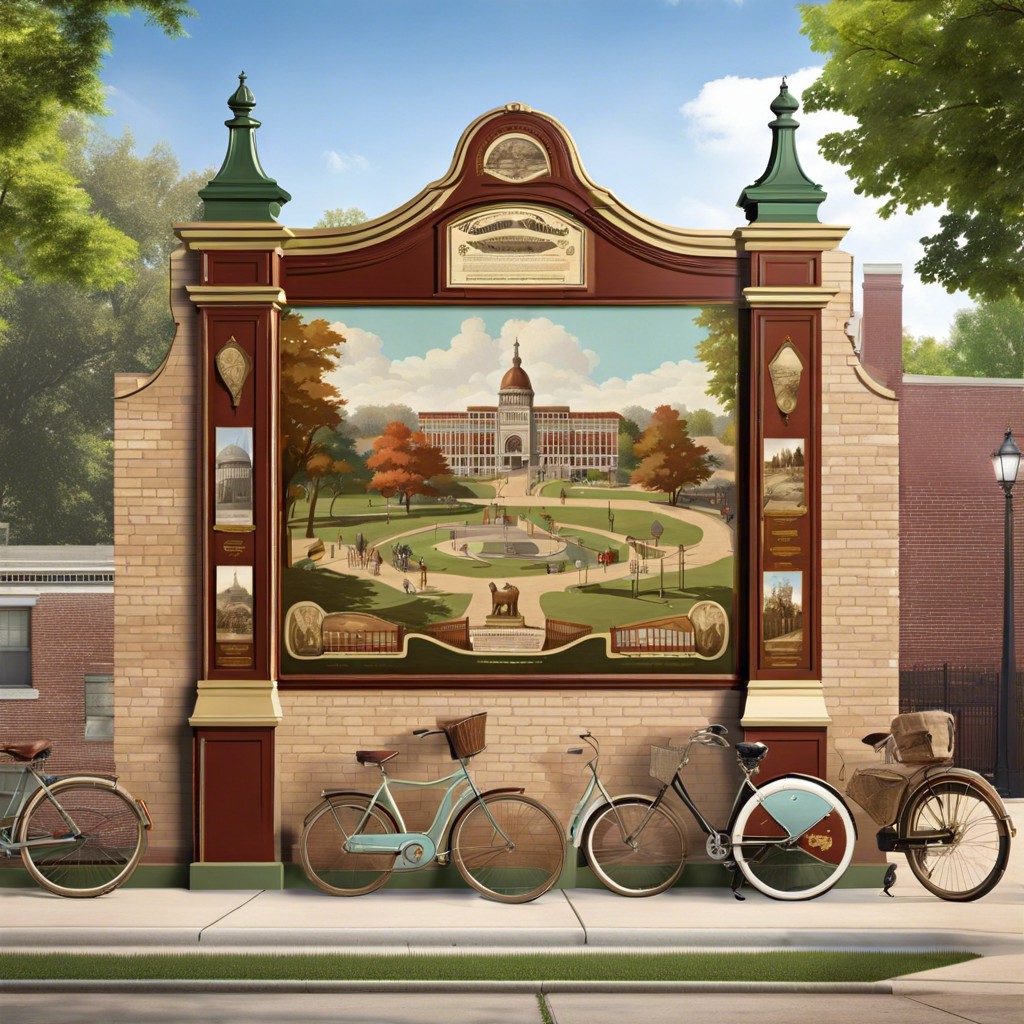Last updated on
Discover the vibrant beauty and intriguing history of yellow uranium glass because it encapsulates fascinating elements of art, science, and time itself.
Key takeaways:
- Yellow uranium glass glows under UV light, creating a captivating effect.
- Vaseline glass gets its yellow-green color from uranium content.
- Uranium glass was made by adding uranium to the glass mix.
- Uranium glass is popular with collectors and artists.
- Health concerns arise from ingestion, but handling poses minimal risk.
Appearance

Characterized by its distinct neon green or yellow hue, this type of glass glows under ultraviolet light, often creating a captivating and otherworldly effect. The intensity of the color can vary, from pale lemon to deep, olive greens, directly influenced by the concentration of uranium dioxide added during the manufacturing process.
In daylight, pieces exhibit a subtle fluorescence, but under UV light, they come alive with an intense and almost eerie glow. This luminous quality not only makes it a collector’s dream but also serves as a practical way to authenticate true uranium glass.
The varying shapes and patterns crafted throughout history reflect different eras and design movements, further adding to the visual allure and historic value of these unique items.
Vaseline Glass

Affectionately named for its resemblance to petroleum jelly, Vaseline glass contains small amounts of uranium, which give it a characteristic yellow-green color. This unique hue is especially vibrant under ultraviolet light, where the glass fluoresces.
The production of Vaseline glass dates back to the 19th century, and it became quite popular during the early 20th century for a variety of objects, including tableware and decorative items. Collectors today often seek vintage pieces, enjoying their distinctive glow and historical charm.
The intensity of the color can vary, from pale lemon to deep, almost neon green, depending on the concentration of uranium dioxide. It’s worth noting that the term ‘Vaseline‘ is a colloquialism rather than a scientific description, and it pertains only to the color and appearance rather than the composition or use of the glass.
Fabrication
Dating back to the 19th century, uranium glass was typically made by adding small amounts of uranium dioxide or a similar compound to a glass mix before melting. The uranium content could range from 0.1% to over 25% by weight, depending on the color intensity desired.
Yellow to green were the most common colors produced through this process, created when the uranium interacted with the iron impurities naturally present in most sands.
The unique fluorescent properties of uranium were often an unintended consequence rather than a specifically sought-after feature during the early production of this glass. Only after the invention of the ultraviolet light did these characteristics become a selling point.
Production peaked in the early to mid-20th century until the availability of uranium for non-military uses was heavily restricted with the advent of the Cold War and nuclear weapons development. Nonetheless, artisans continued to produce uranium glass using stockpiled or recycled uranium until supplies dwindled.
Contemporary craftsmen still occasionally make uranium glass using uranium purchased through regulated channels, preserving the legacy of this unique material. The fabrication is closely monitored to ensure safety for both the artisans and the eventual owners of the glassware.
Modern Usage
Today, uranium glass remains a topic of interest for collectors and artists rather than for practical use in everyday items. The revival of interest in retro and vintage products has returned this distinctive glassware to the spotlight, often found in antique stores, online auctions, and at collector’s shows.
Contemporary glass artists sometimes incorporate uranium to create unique fluorescent pieces that capture the nostalgia associated with the glass. Enthusiasts use ultraviolet lights to display the glow, enhancing the visual appeal of their collections.
Meanwhile, educational and scientific exhibits might feature uranium glass to demonstrate the properties of uranium and the history of its commercial applications. It’s worth noting that the production of new uranium glass is limited and strictly regulated, with most available pieces dating back to the early to middle 20th century.
Health Concerns
Uranium glass contains uranium oxide, which can emit low levels of radiation. The radiation from these pieces is typically at a level considered harmless to humans, as it is primarily alpha radiation, which is low in energy and cannot penetrate the skin. However, concern arises from prolonged exposure, particularly if the glass is used for food and beverages, which could potentially lead to internal exposure to radiation.
The primary health concerns associated with uranium glass derive from the ingestion of uranium rather than from radiation exposure. Ingesting small particles of the glass could lead to chemical toxicity, much like other heavy metals, but the glass does not typically release particles unless it is broken. Moreover, concerns are generally more historical as the use of uranium in glassware has significantly decreased due to tighter regulations.
It is worth noting that the consensus among experts suggests that occasional handling and use of uranium glass in a household setting pose minimal health risks. Collectors and enthusiasts are still encouraged to exercise caution by minimizing unnecessary contact and not using these items for food or drink. Regular monitoring with a Geiger counter can provide assurance for those who wish to safely display and enjoy their collections.
Pertinent Regulations
In the United States, uranium glass falls under the Nuclear Regulatory Commission’s (NRC) purview, which permits the distribution of uranium-containing products if they have a uranium-235 concentration of no more than 0.05% by weight. Additionally, the production and sale of such items are dictated by the Agreement States Program, enabling individual states to regulate the use of radioactive materials within their borders, aligning with NRC policies.
Within the European Union, uranium glass is subject to the European Commission’s regulations. Specifically, items must adhere to the Euratom Treaty, ensuring that radiation exposure to the public does not exceed stipulated safety limits. Manufacturers and importers are also mandated to report any usage of uranium to the Euratom authorities for monitoring and control purposes.
It’s important to highlight that despite these regulations, antique uranium glass pieces are generally exempt from such rules, primarily because they were manufactured before the current regulations were put into place. However, the resale of antique uranium glass is typically permissible under provisions concerning vintage or collectible items.
Estimates of the Radiation Exposures
Uranium glass contains very low levels of radiation due to the presence of uranium. The amount of radiation varies depending on the uranium content, which can be from 2% to 25% by weight. Typically, exposure from handling the glass is considered negligible and often compares to the levels encountered during normal daily activities.
When not in use, it is prudent to store uranium glass away from living spaces to minimize cumulative exposure. Using a Geiger counter can provide a quantitative measure of radiation levels to ensure they are within safe limits. However, it’s important to note that the potential radiation dose received from using uranium glass items, such as tableware, is much less than doses received from medical X-rays or natural background radiation.
It has been reported that the external beta and gamma doses from uranium glass pose a minimal health risk. Nonetheless, ingestion or inhalation of particles would present a greater health concern, hence it is recommended not to use damaged or powdered glass.
Despite the low risk, if there are concerns about radiation exposure, particularly for collectors or those regularly handling uranium glass, seeking advice from health physicists or radiological experts may be beneficial.
Distinguishing Characteristics
Identifying uranium glass involves recognizing certain unique features that set it apart from other types of glassware:
1. Color: Most commonly associated with a yellow or green hue, the intensity can range from opaque to translucent. Under normal lighting conditions, pieces can range from lemon yellow to a deep green, depending on the concentration of uranium.
2. Fluorescence: When exposed to ultraviolet (UV) light, uranium glass typically glows a vibrant neon green. This characteristic is the most reliable method to confirm the presence of uranium, as the glow is due to the uranium content.
3. Patterns and Shapes: Uranium glass was popular during the late 19th and early 20th centuries, so many pieces feature Art Nouveau or Art Deco patterns, along with shapes indicative of this period.
4. Maker Marks: Understanding historical manufacturers and their marks can help determine the age and authenticity of the glass. Collectors often familiarize themselves with trademarks and designs specific to notable producers from uranium glass’s peak production era.
By considering these identifiers, enthusiasts can effectively distinguish uranium glass from other collectible glassware, expanding their collections with authentic pieces imbued with the unique qualities of this intriguing material.
Is Uranium Glass Safe?
When it comes to safety, a key concern is the radiation emitted by uranium glass. Uranium is a radioactive element, and the glass does emit measurable levels of radiation. However, it’s essential to put this in perspective.
Firstly, the type of uranium used in glassware is usually depleted uranium, which is less radioactive than the natural form. Moreover, the amount of uranium in the glass is relatively small, typically less than 2% of the overall composition.
For everyday handling, such as collecting or occasional use, the exposure to radiation is minimal and generally considered to be negligible – akin to the levels one might encounter naturally from rocks or the sun. In fact, standing next to a piece of uranium glass is less hazardous than taking a cross-country flight where cosmic radiation exposure is higher.
However, it is prudent to exercise some caution. Using uranium glass for food or beverage storage over extended periods is discouraged, as leaching of uranium salts could potentially occur, although studies have shown this to be a very slow process.
The consensus among health agencies and collectors is that owning and displaying uranium glass is safe, but using it as functional dinnerware is not recommended. Handling the pieces is unharmful; wear and tear such as chips and breaks should be avoided to prevent any potential release of uranium dust.
In the realm of occupational safety, those who work in creating or restoring uranium glass must follow specific health guidelines to mitigate inhalation or ingestion of uranium dust, which poses a more significant risk than external exposure.
For assurance, collectors and enthusiasts might consider using a Geiger counter to check the levels of radiation their pieces emit, keeping in mind that while the readings may confirm the presence of uranium, they do not automatically imply hazard.
Can You Still Buy Uranium Glass?
Yes, uranium glass remains available for purchase through various channels. Collectors and enthusiasts often find pieces at antique stores, estate sales, and online marketplaces, such as eBay or Etsy. Additionally, specialty glass shops may carry reproduction or newly-made uranium glass items. It’s important to verify the authenticity of the glass through its characteristic green fluorescence under UV light.
When acquiring uranium glass, consider the legal restrictions on uranium content in your country, as they vary from place to place.




